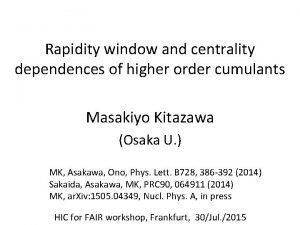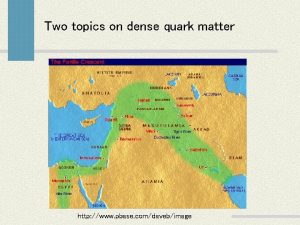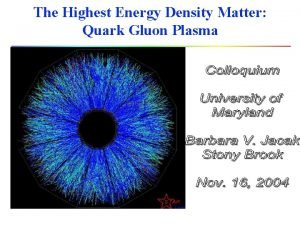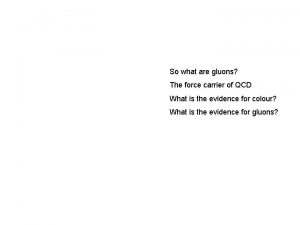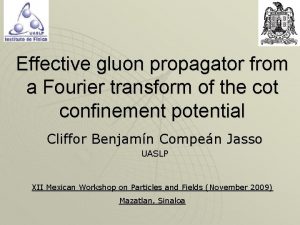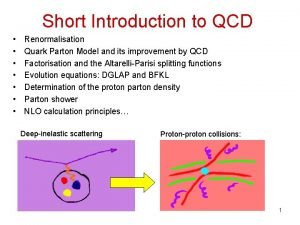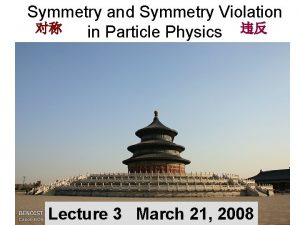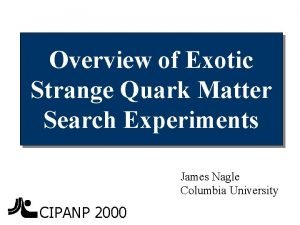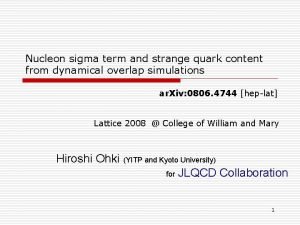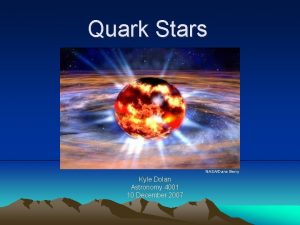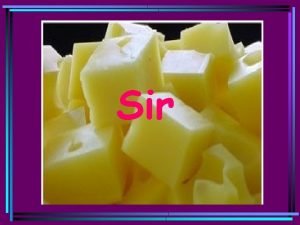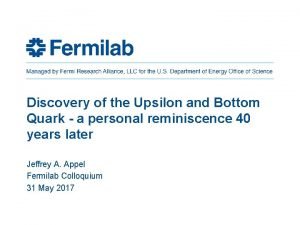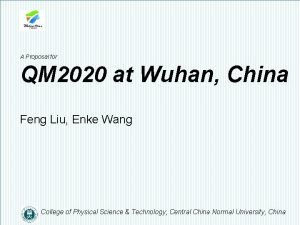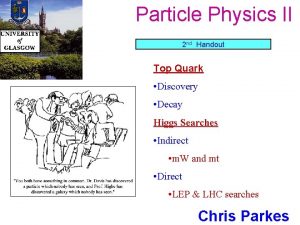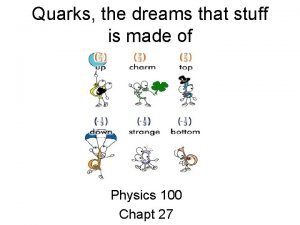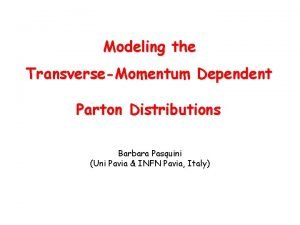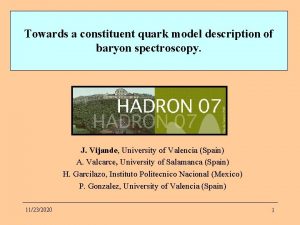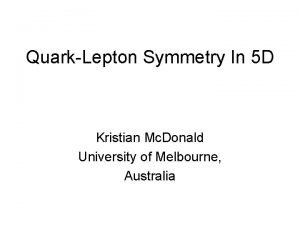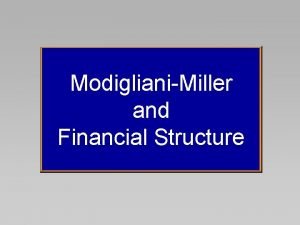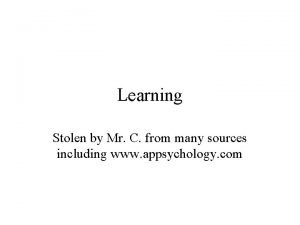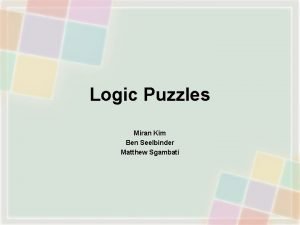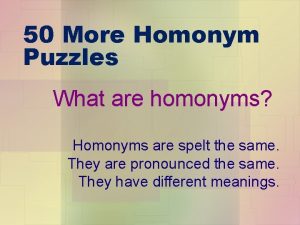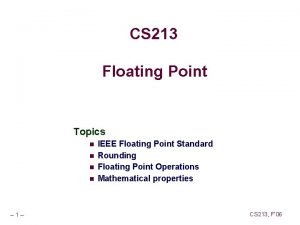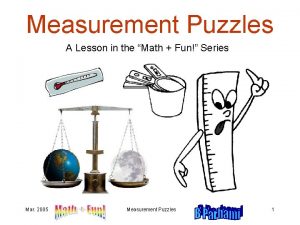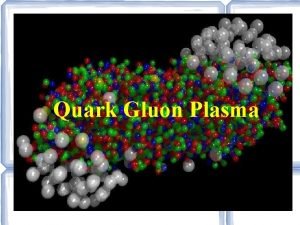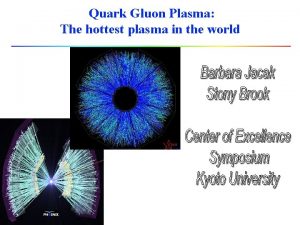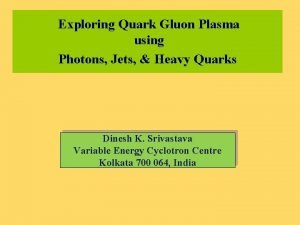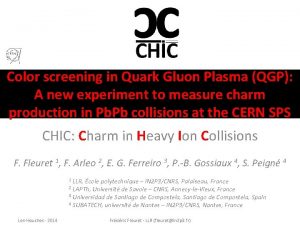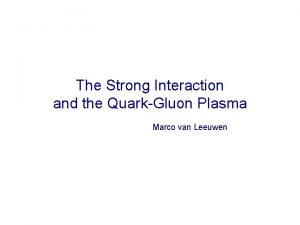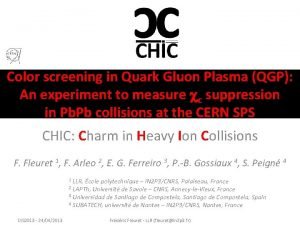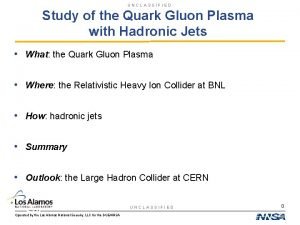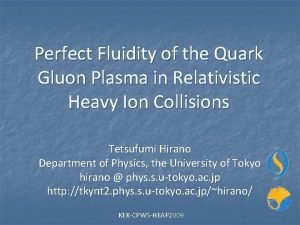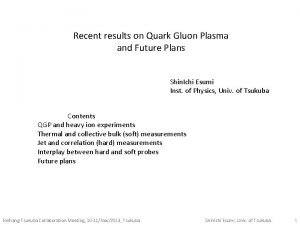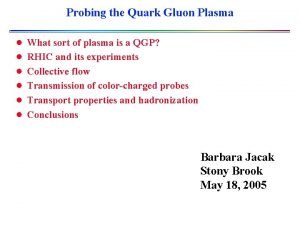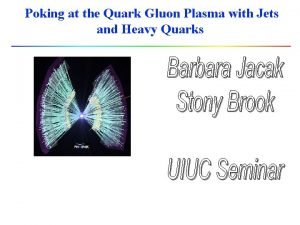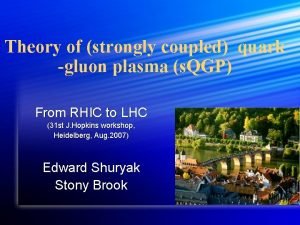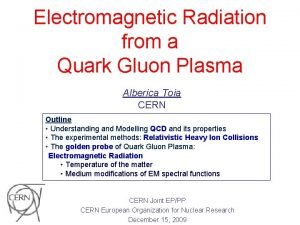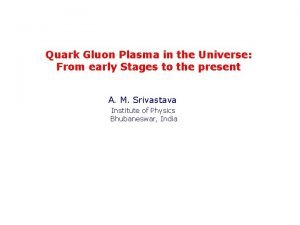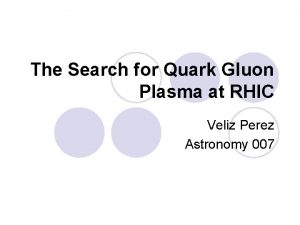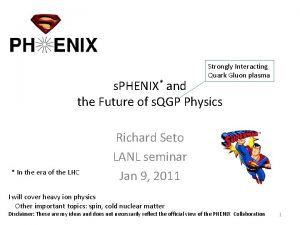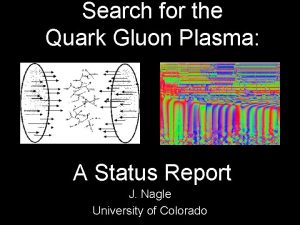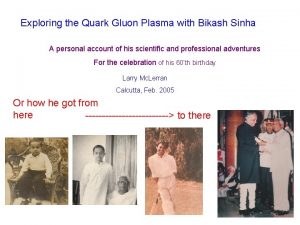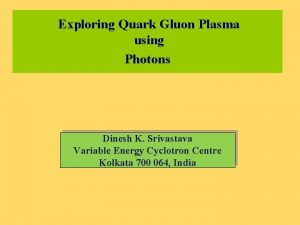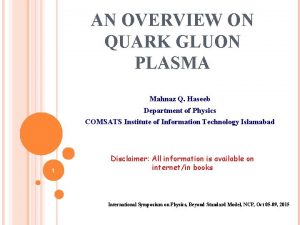Some puzzles in the Quark Gluon Plasma How































- Slides: 31

Some puzzles in the Quark Gluon Plasma How do the phase transition(s) change as a function of: SUSY, Nc = 3. . . ∞, pure glue vs + quarks. . Puzzles: Pure glue: strings persist in the deconfined phase, above Td? Is the deconfining transition at Nc = ∞ special (T ≠ 0, μ = 0)? Baryons at large Nc: di-quark pairing or coherent field? Neutron stars at 2 M⊙ and "stiff" Equations Of State? Quantum thermalization in small systems?

Strings in the deconfined phase for pure SU(N)? "Hidden" scaling of the pressure near Td (M. Panero) Must be strings.

Lattice: usual thermodynamics, pure SU(3) Pure SU(3): no quarks. Peak in (e-3 p)/T 4, just above Td. Borsanyi, Endrodi, Fodor, Katz, & Szabo, 1204. 6184 long tail? ↑ Td 2. 5 Td ↑

Lattice: hidden scaling of the pressure, pure SU(3) (e-3 p)/T 4 x (T 2/Td 2) approximately constant near Tc: Meisinger, Miller, & Ogilvie, ph/0108009; RDP, ph/0608242 Find: T > 1. 2 Td: constant => p(T) ~ # T 2 T < 1. 2 Td: transition region. Narrow? WHOT: Umeda, Ejiri, Aoki, Hatusda, Kanaya, Maezawa, Ohno, 0809. 2842 ↑ Td ↑ 1. 2 Td T/Td→ 2 T d↑

Lattice: hidden scaling, pure SU(3) Td→ 4 Td: For pressure, leading corrections to ideality, T 4, are T 2. Not as flat as WHOT. Borsanyi, Endrodi, Fodor, Katz, & Szabo, 1204. 6184 ↑ Tc T/Td→ 10 Td ↑

Comparison to (resummed) perturbation theory Perturbative contribution to e-3 p ~ g 4 , from trace anomaly HTL pert. theory at NNLO: Andersen, Leganger, Strickland, & Su, 1105. 0514 Clear excess above perturbative below 5 Td. T/Td→

Lattice: hidden scaling, pure SU(N), N=3. . . 8 Pure SU(N): 1/(N 2 -1)(e-3 p)/(T 2 Td 2) ~ constant near Td, independent of N Panero, 0907. 3719; Datta & Gupta, 1006. 0938; Lucini & Panero, 1210. 4997 3 Td ↑ (Td/T)2→ Td ↑

Just mass expansion? For a free massive boson, if m << T, Choose For general m, (e-3 p)/T 2 (E = √k 2 + m 2) : For above m 2, test small 2 mass exp. (e-3 p)/T is not flat for T ~ Td. Term ~ T 2 in pressure in 3+1 dimensions is nontrivial

Lattice: hidden scaling, pure SU(N) in 2+1 dimensions In 2+ 1 dimensions, hidden scaling again ~ T 2: not a mass term, ~ m 2 T: Caselle, Castagnini, Feo, Gliozzi, Gursoy, Panero, Schafer, 1111. 0580 Td/T→ ↑ 10 Td ↑ 2 Td ↑ 1. 1 Td

Do stringy effects persist above Td? For pure SU(N) gauge, lattice finds corrections to ideality are always ~ T 2 : Stringy: ~ T 2 is the free energy of massless fields in two dimensions Not stringy: in deconfined phase, above Hagedorn temperature For SU(N), contributes to pressure ~ N 2, and not ~ N 0: strings color singlets? With dynamical quarks: data not clear. N. B. : only clear with precise lattice data

Pure SU(∞) at the deconfining transition: Gross-Witten-Wadia transition? Exact solution at Td from Ad. S/CFT?

QCD on a femtosphere Consider pure SU(∞) on a spatial sphere so small that coupling is small Sundberg, th/9908001; Aharony, Marsano, Minwalla, Papadodimas, Van Raamsdonk, th/0310285; th/0508077 Dumitru, Lenaghan, RDP, ph/0410294 Integrate out modes with J ≠ 0, obtain eff. theory for static modes, matrix model Consider eigenvalues of Wilson line, L = exp(2 π i q) Take Ai 0 ~ qi , i = 1. . . N. discrete sum Σi => ∫ dq ρ(q). Solve by usual large N tricks. At Td, eigenvalue density is N. B. in 2 -dim. 's, Gross, Witten, & Wadia found 3 rd order transition in lattice β. Here, at any temperature, find 3 rd order transition when

Gross-Witten-Wadia transition at N=∞ Solution at N=∞: “critical first order” transition - both first and second order Latent heat nonzero ~ N 2. And specific heat diverges, Cv ~ 1/(T-Tc)3/5 Potential function of all tr Ln, n = 1, 2. . But at Td+, only first loop is nonzero: Potential not analytic at l = 1/2 ↓ But Veff flat between them! tr Ln (Td) = 0 , n ≥ 2 ↑ 0 ↑ 1/2 Above only for g=0: to ~ g 4, standard 1 st order transition. So GWW curiosity?

Matrix models in infinite volume Construct effective matrix model for deconfinement: Meisinger, Miller, & Ogilvie, ph/0108009. A. Dumitru, Y. Guo, Y. Hidaka, C. Korthals-Altes & RDP, 1011. 3820, 1205. 0137; K. Kashiwa, V. Skokov & RDP, 1205. 0545; K. Kashiwa & RDP, 1301. 5344. (Gauge invariant) variables eigenvalues of (thermal) Wilson line: Simple ansatz: constant, diagonal A 0: At 1 -loop order, perturbative potential Assume non-perturbative potential ~ T 2 Td 2:

Matrix models in infinite volume, N = ∞ Solve at N=∞: RDP & V. Skokov, 1206. 1329; Interface tensions: S. Lin, RDP, & V. Skokov, 1301. 7432 Take derivatives of equation of motion, at Td solution At Td, solution identical to GWW model on a femtosphere! Solution differs away from Td. But why same solution at Td? Veff very different. On a femtosphere, coupling is fixed, g 2(1/R), couplings don't run. But in infinite volume, coupling constants can flow: Is Gross-Witten-Wadia an infrared stable fixed point for pure gauge SU(∞)?

Remnants of Gross-Witten-Wadia at finite N? At finite N, solve model numerically. Find two minima, at 0 and ~ 1/2. Standard first order transition, with barrier & interface tension nonzero Barrier disappears at infinite N: so interface tensions vanish at infinite N Below: potential /(N 2 -1), versus tr L. 0↑ ↑ 1/2

Signs of GWW at finite N: interface tensions small at Td? Consider maximum of previous figure, versus number of colors: increases by ~ 2 from N = 3 to 5, then decreases monotonically as N increases Perhaps: non-monotonic behavior of order-disorder interface tension with N? Below: maximum in potential /(N 2 -1), versus tr L. Lattice: order-disorder interface tension αod at Td: Lucini, Teper, Wegner, lat/0502003 Coefficients small, χ2 large, ~ 2. 8. Non-monotonic behavior of αod /N 2? 't Hooft loops also small near Td Remnants of Gross-Witten-Wadia fixed point at finite N?

Effective theory for deconfinement? There's always some effective theory: Ad. S/CFT?

Matrix model: parameters from the lattice Matrix model: choose variables as eigenvalues of thermal Wilson line Choose 2 free parameters to fit: latent heat at Td, (e-3 p)/T 4 at large T Reasonable value for bag constant B: c 1 =. 88, c 2 =. 55, c 3 =. 95 Td = 270 Me. V, B~ (262 Me. V)4 ⇐ Lattice Latent heat, lattice: Beinlich, Peikert, Karsch lat/9608141 Datta, Gupta 1006. 0938 ⇐ 2 -parameter model ↑ Td T/Td→ 3 Td ↑

Matrix model: ‘t Hooft loop vs lattice Matrix model works well: Lattice: de Forcrand, D’Elia, & Pepe, lat/0007034; de Forcrand & Noth lat/0506005 lattice, N=3 ⇒ ⇐ N=2 Semi-classical⇒ ⇐ matrix model, N = 3 ↑ Td T→ 5 Td ↑

Polyakov loop: vs lattice: huge discrepancy Renormalized Polyakov loop from lattice nothing like Matrix Model: transition region narrow, to ~ 1. 2 Tc. Lattice: loop wide, to ~ 4. 0 Tc. Can alter parameters to fit Polyakov loop; do not fit latent heat with 2 parameters Are the eigenvalues of the (thermal) Wilson line enough? Other variables? 1 -parameter ⇓ ⇐ 2 parameter ⇑ 0 -parameter Lattice: Gupta, Hubner, and Kaczmarek, 0711. 2251. ⇐ lattice ↑ Td T→ 1. 5 Td ↑

Axial charge for heavy quarks: Is g. A ~ N at large N?

Baryons at large N: g. A ~ N? Non-relativistic quark model: g. A = (N+2)/3 ~ N at large N. N = 3: g. A = 5/3. But even for heavy quarks, g. A ~ 1. As mπ → 0, approaches g. Aexp~1. 2 from below Is g. A ~ N at large N? Diquark pairing? Hidaka, Kojo, Mc. Lerran, RDP, 1004. 0261 Diquark pairing vs pion cloud? T. Kojo 1208. 5661 RBC + UKQCD, Yamazaki et al, 0801. 4016.

Equation Of State for cold, dense quarks: severe constraints from neutron stars EOS from Ad. S/CFT?

Neutron stars "Most" neutron stars: masses ~ 1. 4 M⊙, max. density ~ 2 -3 ρ0 (nucl. matter) Recently: PSR J 1614 -2230 : 1. 97 ± 0. 04 M⊙ PSR J 0348+0432: 2. 01 ± 0. 04 M⊙ These use a GR effect, Shapiro time delay, to determine the mass Other candidates with large masses, but much larger errors. Lattimer, 1305. 3520; Prakash, 1307. 0397

Neutron stars and "stiff" Equations Of State To obtain M ~ 2 M⊙, need "stiff" Equation Of State EOS "stiff" if speed of sound cs > c/√ 3. Stiffest possible: cs = c. For M ~ 2 M⊙, need cs 2 > 0. 4 c 2. Lattimer, 1305. 3520; Prakash, 1307. 0397 Severe constraint on EOS. 1 st order transition: cs = 0 in mixed phase Strange quarks: new degrees of freedom soften EOS. Stiffest EOS: Not like the T 2 term in pressure: sign positive!

Lattice & neutron stars HAL QCD, Inoue et al, 1307. 0299: Determine VNN from lattice. . . input into EOS Assume Mmax ~ a/(mπ + b) + c. Not mπ2. Can obtain Mmax ~ 2. 2 M⊙, if: No 1 st order transition, no strange quark matter.

Quantum thermalization in small systems Ad. S/CFT?

Eigenstate thermalization hypothesis In quantum mechanics, consider evolution in time for some operator A: At large times, only the diagonal elements survive: Assume that one probes the system at high energy E, in a narrow interval ΔE: eigenstate thermalization hypothesis: each state close to thermal, ≈ microcanonical ensemble. "Quantum" thermalization for isolated quantum systems. von Neumann, '29 Deutsch, '91, Srednicki, cond-mat/9403051; Rigol, Dunjko, Olshanii, 0708. 1324 =>

Quantum thermalization in hadronic collisions Assume quantum wave function has spread in temperature, with power law tail: related to Tsallis statistics, T 0 = TTsallis/(1 -q), α=1/(1 -q) Urmossy, 1212. 0260 Extremely successful fit to all hadronic collisions: e+e-, pp, p. A, AA. For pp: √s α T 0 62 14 1600 200 11 1130 900 8. 6 830 7000 7. 75 767

Await results from Ad. S/CFT!
 Quark gluon plasma
Quark gluon plasma Quark gluon plasma
Quark gluon plasma Quark gluon
Quark gluon Quark gluon
Quark gluon What are gluons
What are gluons Gluon propagator
Gluon propagator Gluon plugin
Gluon plugin Quark parton model
Quark parton model A charm quark has a charge of approximately
A charm quark has a charge of approximately Quarks
Quarks Sigma quark composition
Sigma quark composition Quark astronomy
Quark astronomy Dimsi sir
Dimsi sir Quark names
Quark names Quark matter 2022
Quark matter 2022 Top quark decay
Top quark decay 6 types of quarks
6 types of quarks Quark model
Quark model Constituent quark model
Constituent quark model Quark names
Quark names Physics wordle quark
Physics wordle quark Quark lepton symmetry
Quark lepton symmetry Eight basic puzzles about financial structure
Eight basic puzzles about financial structure Paid 10 dollars for every 20 puzzles solved
Paid 10 dollars for every 20 puzzles solved Stars plowhorses puzzles dogs
Stars plowhorses puzzles dogs Logic puzzles
Logic puzzles Homonyms ball
Homonyms ball Floating point puzzles
Floating point puzzles Homonym of ship
Homonym of ship Measurement puzzles
Measurement puzzles Riddles for gifted students
Riddles for gifted students Wisc 5 descriptive categories
Wisc 5 descriptive categories

